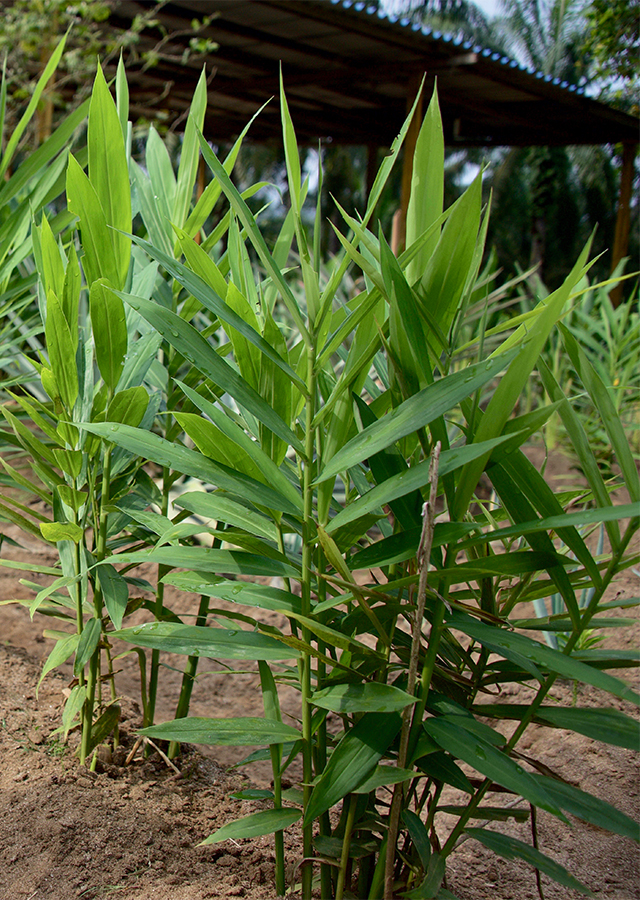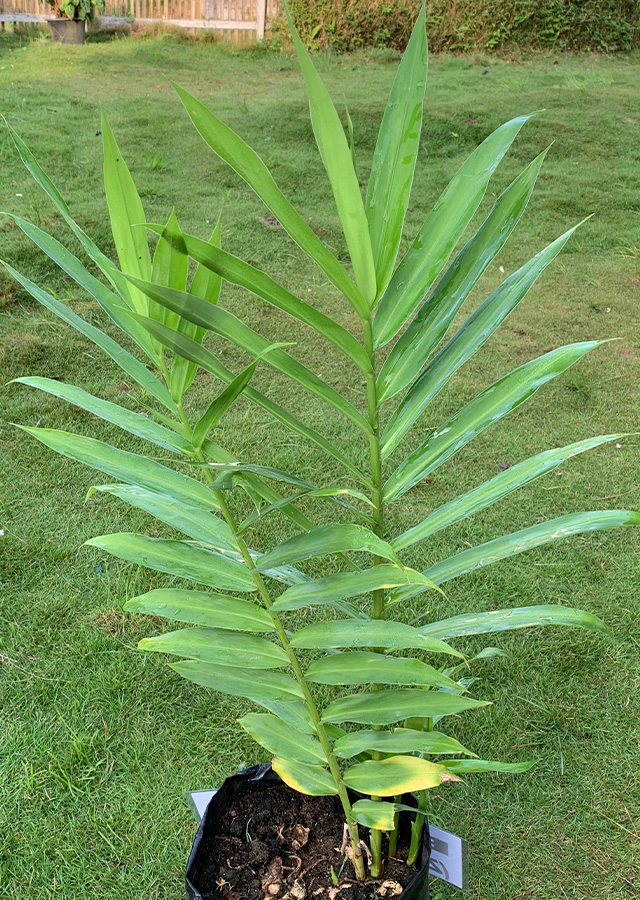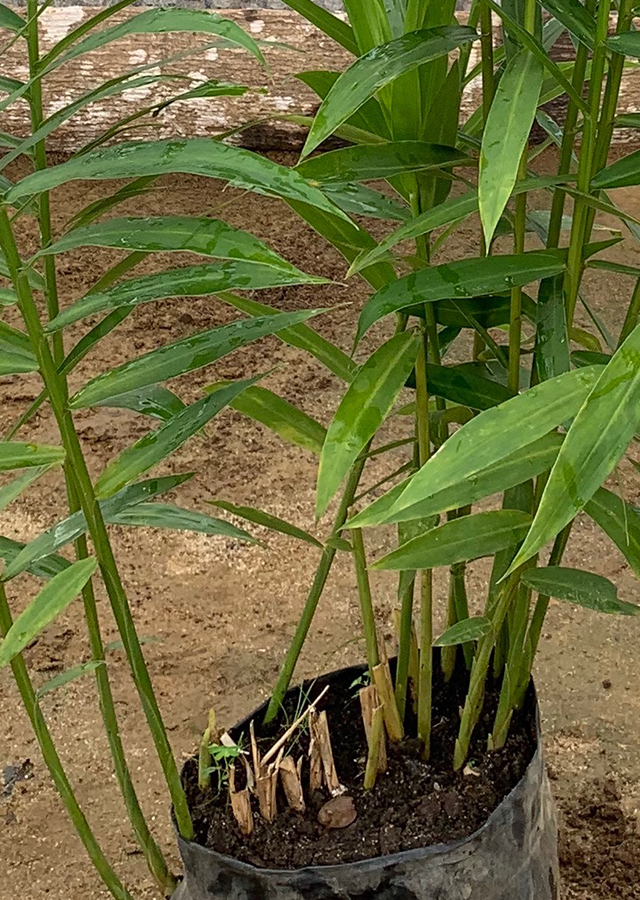Bengal ginger
Zingiber purpureum Roscoe
Zingiberaceae
Location in our garden
Principal



Synonym
Amomum cassumunar (Roxb.) Donn
Amomum xanthorhiza Roxb. ex Steud.
Cassumunar roxburghii Colla
Habitus
Herbaceous. Herbaceous perennial plant, grows up to 1-1,5 m
Part Used
Leaves
Rhizome
Growing Requirements
Full Sunshine
Need Shade
Habitat
Forest
Overview
It is native to Southeast Asia and was introduced to Europe and the neo-tropics, where it has naturalized in many places. As the largest family in the Zingiberales, Zingiberaceae, the ‘ginger’ family, includes approximately 53 genera and over 1,200 species distributed in all tropical regions of the world, with highest concentration in Southeast Asia. Native to Assam, Bangladesh, East Himalaya, India, Myanmar. Introduce into: Borneo, Cambodia, China Southeast, Cuba, Dominican Republic, Haiti, Lesser Sunda Is., Malaya, Philippines, Puerto Rico, Sri Lanka, Thailand, Vietnam
Vernacular Names
Bolai (Malaysia), Blae kobor (Thailand), Bon ada (Bangladesh), Jangliadrak (India), Blockzitwer (German), Gingembre marron (French). Bengal ginger (English), Bangle, Banglai, Bengle (Aceh, Indonesia), Jengibre Amargo (Cuba), Ye Jiang (Chinese), Meik-Thalin (Burmese)
Agroecology
Zingiber is commonly found in moist, partially shaded evergreen and monsoon forests on soils rich in organic matter, but also in secondary forests, open habitats at forest edges, disturbed sites and bamboo thickets on rocky soils at altitudes up to 3,000 m. It performs best in partially shaded areas with moist, humus-rich soil.
Morphology
- Rhizomes - internally pale carrot colour, with a spicy aroma with a bitter and spicy taste
- Pseudostems - 1.2-1.8 m tall.
- Leaves - sessile or short-petiolate; sheaths glabrous or pubescent along edges, green, sparsely pubescent, bi-lobed; blades linear to linearlanceolate or broadly lanceolate, hirsute adaxially, acuminate at apex, narrowly cuneate at base.
- Flowers - fusiform or cylindric-ovate, acute at apex, the shoot (scape) erect, mature bractsovate, pubescent, with a subscarious, greenish, black-lineolate margin, red or purplish brown; bracteoles ovate, 1-1.5 cm long, 3-dentate. Calyx 1.2-1.5 cm long, membranous, truncate, unilaterally split, white, glabrous; corolla 4-6 cm long, the lobes linear-lanceolate, pale yellow to white. Spherical flower
Cultivation
Propagated by seeds and by rhizome division. Vegetative propagation rate through rhizomes is slow, however, yielding only 4-6 plants per rhizome each year. Bangle planted in sheltered places. Grows to form dense and tall clumps.
Chemical Constituents
Sineol, pinen, tannins, saponins, flavonoids, steroids, essential oils (sabinene, Y-terpinene, terpinen-4-ol, butadiene).
Traditional Medicinal Uses
Medicinal Uses
- The root is stimulant, stomachic and tonic. It is used in the treatment of diarrhoea and colic.
- Studies have shown analgesic activity, antimicrobial activity, anti-inflammatory activity, anticancer and radical scavenging activity and anti-malarial activity.
Traditional Uses
- In Indonesia, the pounded rhizome is used as a poultice against headache, and in a variety of medicinal mixtures.
- The rhizome is administered internally as a vermifuge in Malaysia and for postpartum medication.
- In Laos, it is applied against abscesses, fever, colic, diarrhoea and other intestinal disorders, a depurative, as well as a poison antidote.
- In Thailand, the species is the prime ingredient in massage oil to relieve muscle pain, and the rhizomes are taken against asthma.
- In Northeast India, oral consumption of the rhizome paste was reported to treat dyspepsia and stomach bloating.
Part Used
Reference Sources
- CABI. (2014). Invasive Species Compendium. Zingiber cassumunar. https://www.cabi.org/isc/datasheet/57536. 16-01-2021
- Pharmacognosy. (2015). Ethnobotany, Phytochemistry and Pharmacology of Zingiber cassumunar Roxb. (Zingiberaceae). Cb Singh, Manglembi N, Swapana N, Sb Chanu. Ethnobotany, Phytochemistry and Pharmacology of Zingiber cassumunar Roxb. (Zingiberaceae). J Pharmacogn Phytochem 2015;4(1):01-06. https://www.phytojournal.com/archives/?year=2015&vol=4&issue=1&ArticleId=535 16-01-2021
- Researchgate. (2009). Zingiber cassumunar. 16-01-2021 https://www.researchgate.net/publication/237046149_Chemical_Composition_and_Physical_Properties_of_Oil_from_Plai_Zingiber_cassumunar_Roxb_Obtained_by_Hydro_Distillation_and_Hexane_Extraction. 16-01-2021.
- Lim, TK. 2016. Edible Medicinal and Non-Medicinal Plants: Volume 12 Modified Stems, Roots, Bulbs. Springer 2016: 690 Hal 15 November 2021
- https://www.gbif.org/species/101439804 15 November 2021
- https://www.gbif.org/species/105756360 15 November 2021
- https://www.cabi.org/isc/datasheet/57536 15 November 2021
- Anggraini FP. 2015. Efek kombinasi minyak atsiri bangle (Zingiber purpureum Roxb.) dan Jahe merah (Zingiber officinale var rubrum) sebagai antibakteri terhadap Staphylococcuc aureus dan Escherichia coli. (Skripsi). Fakultas Farmasi, Universitas Jember. 15 November 2021.
- http://www.plantsoftheworldonline.org/taxon/urn:lsid:ipni.org:names:798381-1 15 November 2021

